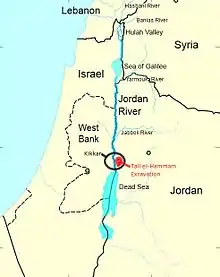Steven Collins (archaeologist)
Steven Collins (born September 11, 1950) is an American professor with the College of Archaeology at the unaccredited Trinity Southwest University in Albuquerque, New Mexico, an institution that states that biblical scripture is the "divinely inspired representation of reality given by God to humankind, speaking with absolute authority in all matters upon which it touches".[1] Collins is also the Professor of Archaeology and Biblical History along with Professor of Biblical and Theological Studies at Veritas International University,[2] which is accredited by the Transnational Association of Christian Colleges and Schools which requires all accredited schools to have a statement of faith that affirms "the inerrancy and historicity of the Bible" and "the divine work of non-evolutionary creation including persons in God's image".[3] He has been working as an archaeologist for 30 years, researching and teaching on Near Eastern archaeology and biblical studies.

Excavations at Tall el-Hammam
Collins is the chief archaeologist and co-director of the Tall el-Hammam Excavation Project in Jordan, working with the Department of Antiquities of the Hashemite Kingdom of Jordan. He began the project in 2005, and his archaeological investigations have found the remains of a fortified city that was destroyed circa 1850–1650 BCE.[4] In the late 2000s, Collins claimed that the site was likely to be the location of the biblical city of Sodom. The Tall el-Hammam Excavation Project is located in Jordan, about 14 km northeast of the Dead Sea, an area east of the Jordan River straddling Highway 65, just north of the Dead Sea (31°50′25″N 35°40′27″E).[5][6][7][8][9][10] Burnt brick and melted pottery[11] were found at the site and in the Jordon River valley near Sowayma, and skeletons were twisted and mangled.[12]
Based on the literal use of biblical numbers, Professor Eugene H. Merrill believes that the identification of Tall el-Hammam with Sodom would require an unacceptable restructuring of the biblical chronology.[13][14] Collins has responded to these arguments.[15]
Collins's Near Eastern archaeology work in Jordan is the topic of his current book about the location of biblical Sodom. He has appeared on US and international television and radio programs.[16] He has also lectured in the US, Europe, the Middle East and Africa.[17][18][19][20][21]
Books
- Collins, S., Kobs, C.M., & Luddeni, M.C. The Tall al-Hammam Excavations, Volume 1: An Introduction to Tall al-Hammam: Seven Seasons (2005–2011) of Ceramics and Eight Seasons (2005–2012) of Artifacts from Tall al-Hammam., Eisenbrauns 2015 ISBN 978-1-57506-369-0
- Collins, S., & Scott, L. Discovering the City of Sodom: The Fascinating, True Account of the Discovery of the Old Testament's Most Infamous City, Howard Books 2013 ISBN 978-1451684308
- Collins, S. Let My People Go!: Using historical synchronisms to identify the Pharaoh of the Exodus, Trinity Southwest University Press, 2012 ISBN 978-0615687940
References
- Doctrinal Position, Trinity Southwest University website, accessed March 10, 2012
- http://viu.ves.edu/graduate-post-graduate/
- "Accreditation Standards" (PDF). Transnational Association of Christian Colleges and Schools. 2009. Retrieved 2008-12-26. page 80 also see: "Biblical Creation. Special creation of the existing space-time universe and all its basic systems and kinds of organisms in the six literal days of the creation week." on page 81
- Collins, Steven. “A Response to Bryant G. Wood’s Critique of Collins’ Northern Sodom Theory.” Biblical Research Bulletin 7, no. 7 (2007): 27; Collins, Steven. “Sodom: The Discovery of a Lost City.” Bible and Spade 20, no. 3 (2007): 72
- "Looking Back; Claims to new Sodom locations are salted with controversy", Christianity Today, April 2008
- "Archaeologists Return to Excavate Possible Site of Biblical Sodom". Popular-archaeology.com. Archived from the original on 18 October 2016. Retrieved 1 August 2017.
- "Archaeologists Excavate Massive Ancient Gateway in Jordan". Popular-archaeology.com. Archived from the original on 16 October 2015. Retrieved 1 August 2017.
- MA, Gary Byers. "Tall el-Hammam 2008: A Personal Perspective". Biblearchaeology.org. Retrieved 1 August 2017.
- "Tall el-Hammam, Jordan - Find a Dig". Digs.bib-arch.org. Retrieved 1 August 2017.
- David E. Graves, The Location of Sodom: Color Edition. Key Facts for Navigating the Maze of Arguments for the Location of the Cities of the Plain (Toronto: Electronic Christian Media, 2018) map 9 page 193.
- "Making the Case for Sodom". June 5, 2014. Retrieved 14 May 2017.
- "LeCompte, Swindell Sodom and Gomorrah Research". nia.ecsu.edu. May 11, 2016. Retrieved 14 May 2017.
- Merrill, Eugene H. "Texts, Talls, and Old Testament Chronology: Tall Hammam as a Case Study." Artifax 27, no. 4 (2012): 20–21.
- Bolen, Todd (2013-02-27). "Arguments Against Locating Sodom at Tall el-Hammam". Biblical Archaeology Society. Retrieved 3 July 2013.
- Contra Collins, Steven. "Tall el-Hammam Is Still Sodom: Critical Data-Sets Cast Serious Doubt on E. H. Merrill’s Chronological Analysis. Archived 2013-09-27 at the Wayback Machine" (PDF) Biblical Research Bulletin 13, no. 1 (2013): 1–31.
- National Geographic Ancient X-Files: Season 2 Episode 4-Sodom and Gomorrah http://www.dailymotion.com/video/x2mwr5a Ghazwan Mattaka Secrets of the Bible: Season 1 Episode 14-The Search for Sodom http://www.dailymotion.com/video/x30dv4e
- "Steven Collins, DMin, PhD, Prof. Biblical Studies & Apologetics: Trinity Southwest University". Trinitysouthwest.com. Retrieved 1 August 2017.
- "Dr. Collins : Trinity Southwest University". Trinitysouthwest.com. Retrieved 1 August 2017.
- "linkedin.com, Steven Collins Phd". Linkedin.com. Retrieved 1 August 2017.
- Encyclopedia of Christian Education, Volume 3, edited by Kurian, George Thomas & Mark A. Lamport, p. 1608, May 7, 2015.
- Holden, Joseph M. The Popular Handbook of Archaeology and the Bible, August 1, 2013.